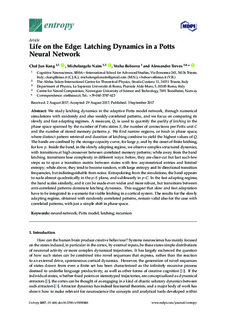| dc.description.abstract | We study latching dynamics in the adaptive Potts model network, through numerical simulations with randomly and also weakly correlated patterns, and we focus on comparing its slowly and fast adapting regimes. A measure, Q, is used to quantify the quality of latching in the phase space spanned by the number of Potts states S, the number of connections per Potts unit C and the number of stored memory patterns p. We find narrow regions, or bands in phase space, where distinct pattern retrieval and duration of latching combine to yield the highest values of Q. The bands are confined by the storage capacity curve, for large p, and by the onset of finite latching, for low p. Inside the band, in the slowly adapting regime, we observe complex structured dynamics, with transitions at high crossover between correlated memory patterns; while away from the band latching, transitions lose complexity in different ways: below, they are clear-cut but last such few steps as to span a transition matrix between states with few asymmetrical entries and limited entropy; while above, they tend to become random, with large entropy and bi-directional transition frequencies, but indistinguishable from noise. Extrapolating from the simulations, the band appears to scale almost quadratically in the p–S plane, and sublinearly in p–C. In the fast adapting regime, the band scales similarly, and it can be made even wider and more robust, but transitions between anti-correlated patterns dominate latching dynamics. This suggest that slow and fast adaptation have to be integrated in a scenario for viable latching in a cortical system. The results for the slowly adapting regime, obtained with randomly correlated patterns, remain valid also for the case with correlated patterns, with just a simple shift in phase space. | nb_NO |

